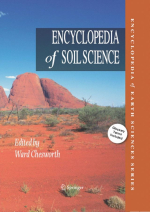Добрый день, Коллеги. Важное сообщение, просьба принять участие. Музей Ферсмана ищет помощь для реставрационных работ в помещении. Подробности по ссылке
Encyclopedia of soils science / Энциклопедия наук о почвах
Darwin’s tangled bank is the biosphere in poetic microcosm, and the “damp earth” he refers to is soil. Soil is arguably the most complex of all geological materials, a combination of mineral and organic constituents in solid, aqueous and gaseous forms, organized into a loose, porous, horizonated, plant-bearing material, that is constantly changing. It forms as a result of a complex series of interactions and feedbacks between lithosphere, hydrosphere, atmosphere and, biosphere. As the natural geological cover of most of the land surface of the earth, it is the focus of this encyclopedia.
Alfred North Whitehead2 once wrote that the European philosophical tradition “consists of a series of footnotes to Plato”. It might similarly be said that human history is little more than a footnote to the exploitation of soil that started with the Agricultural, or Neolithic, Revolution, 10 000 years ago. All the magnificent cultural artifacts of civilization, from cathedrals to efficient plumbing systems, are the direct heritage of this exploitation, and the big question today concerns what humanity must do to sustain the heritage. At the most fundamental level this is equivalent to asking what we must do to sustain our food-production system.
By way of answer, consider Felipe Fernández-Armesto’s definition of civilization: “a relationship to the natural environment, recrafted by the civilizing impulse, to meet human demands”. To sustain the food-production system, we need to avoid making our demands so great, and our recrafting so extreme, that the biosphere in which we are embedded breaks down as a life-support system. Unfortunately, agriculture, the very technology we depend upon to maintain our complex societies, is strategically situated to threaten the biosphere at a vulnerable bottleneck, the soil. Soil occupies a kind of choke point through which virtually all of the fluxes of energy and matter that keep the terrestrial biosphere functioning, are squeezed between different compartments of the landscape, and for about ten millennia we have been commandeering an ever growing area of the soil for human use. <...>




